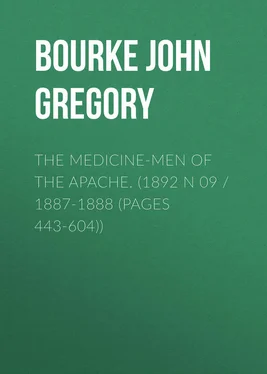John Bourke - The Medicine-Men of the Apache. (1892 N 09 / 1887-1888 (pages 443-604))
Здесь есть возможность читать онлайн «John Bourke - The Medicine-Men of the Apache. (1892 N 09 / 1887-1888 (pages 443-604))» — ознакомительный отрывок электронной книги совершенно бесплатно, а после прочтения отрывка купить полную версию. В некоторых случаях можно слушать аудио, скачать через торрент в формате fb2 и присутствует краткое содержание. Жанр: foreign_antique, foreign_prose, на английском языке. Описание произведения, (предисловие) а так же отзывы посетителей доступны на портале библиотеки ЛибКат.
- Название:The Medicine-Men of the Apache. (1892 N 09 / 1887-1888 (pages 443-604))
- Автор:
- Жанр:
- Год:неизвестен
- ISBN:нет данных
- Рейтинг книги:4 / 5. Голосов: 1
-
Избранное:Добавить в избранное
- Отзывы:
-
Ваша оценка:
- 80
- 1
- 2
- 3
- 4
- 5
The Medicine-Men of the Apache. (1892 N 09 / 1887-1888 (pages 443-604)): краткое содержание, описание и аннотация
Предлагаем к чтению аннотацию, описание, краткое содержание или предисловие (зависит от того, что написал сам автор книги «The Medicine-Men of the Apache. (1892 N 09 / 1887-1888 (pages 443-604))»). Если вы не нашли необходимую информацию о книге — напишите в комментариях, мы постараемся отыскать её.
The Medicine-Men of the Apache. (1892 N 09 / 1887-1888 (pages 443-604)) — читать онлайн ознакомительный отрывок
Ниже представлен текст книги, разбитый по страницам. Система сохранения места последней прочитанной страницы, позволяет с удобством читать онлайн бесплатно книгу «The Medicine-Men of the Apache. (1892 N 09 / 1887-1888 (pages 443-604))», без необходимости каждый раз заново искать на чём Вы остановились. Поставьте закладку, и сможете в любой момент перейти на страницу, на которой закончили чтение.
Интервал:
Закладка:
Finger of birth-strangled babe,
Ditch-deliver'd by a drab. 165 165 Shakespeare, Macbeth, act 4, scene 1.
"Scrofula, imposthumes of the parotid glands, and throat diseases, they say, may be cured by the contact of the hand of a person who has been carried off by an early death;" but, he goes on to say, any dead hand will do, "provided it is of the same sex as the patient and that the part affected is touched with the back of the left hand." 166 166 Pliny, Nat. Hist., lib. 28, cap. 11.
A footnote adds that this superstition still prevails in England in regard to the hand of a man who has been hanged.
The use of dead men's toes, fingers, spinal vertebræ, etc., in magical ceremonies, especially the fabrication of magical lamps and candles, is referred to by Frommann. 167 167 Tractatus de Fascinatione, Nuremberg, 1675, p. 681.
Grimm is authority for the statement that in both France and Germany the belief was prevalent that the fingers of an unborn babe were "available for magic." 168 168 Teutonic Mythology, vol. 3, p. 1073.
In England witches were believed to "open graves for the purpose of taking out the joints of the fingers and toes of dead bodies … in order to prepare a powder for their magical purposes." 169 169 Brand, Pop. Ant., vol. 3, p. 10.
"Saint Athanase dit même, que ces parties du corps humain [i.e., hands, feet, toes, fingers, etc.] étoient adorées comme des dieux particuliers." 170 170 Montfaucon, l'Antiquité expliquée, vol. 2, liv. 4, cap. 6, p. 249.
According to the sacred lore of the Brahmans "the Tirtha sacred to the Gods lies at the root of the little finger, that sacred to the Rishis in the middle of the fingers, that sacred to Men at the tips of the fingers, that sacred to Agni (fire) in the middle of the hand." 171 171 Vâsish th a, cap. 3, pars. 64-68, p. 25 (Sacred Books of the East, Oxford, 1882, Max Müller's edition).
In the Island of Ceylon "debauchees and desperate people often play away the ends of their fingers." 172 172 Travels of Two Mohammedans through India and China, in Pinkerton's Voyages, vol. 7, p. 218.
Hone shows that "every joint of each finger was appropriated to some saint." 173 173 Every-Day Book, vol. 2, col. 95.
NECKLACES OF HUMAN TEETH
A number of examples are to be found of the employment of necklaces of human teeth. In my own experience I have never come across any specimens, and my belief is that among the Indians south of the Isthmus such things are to be found almost exclusively. I have found no reference to such ornamentation or "medicine" among the tribes of North America, but there are many to show the very general dissemination of the custom in Africa and in the islands of the South Sea. Gomara says that the Indians of Santa Marta wore at their necks, like dentists, the teeth of the enemies they had killed in battle. 174 174 "Traen los dientes al cuello (como sacamuelas) por bravosidad." – Gomara, Historia de las Indias, p. 201.
Many of the Carib, we are told by a Spanish writer, ostentatiously wear necklaces made of strings of the teeth of the enemies whom they have slain. 175 175 "Los Caberres y muchos Caribes, usan por gala muchas sartas de dientes y muelas de gente para dar á entender que son muy valientes por los despojos que alli ostentan ser de sus enemigos que mataron." – Gumilla, Orinoco, Madrid, 1741, p. 65.
Padre Fray Alonzo Fernandez says of the Carib: "Traen los dientes con los cabellos de los que mataron por collares, como hazian antiguamente los Scitas." 176 176 Padre Fray Alonzo Fernandez, Historia Eclesiastica, Toledo, 1611, p. 17.
The people of New Granada "traen al cuello dientes de los que matavan." 177 177 Ibid., p. 161.
Picart says that the natives of New Granada and Cumana "portent au col les dents des ennemis qu'ils ont massacrez." 178 178 Cérémonies et Coûtumes, Amsterdam, 1735, vol. 6, p. 114.
The Spaniards found in the temple of the Itzaes, on the island of Peten, an idol made of "yesso," which is plaster, and in the head, which was shaped like the sun, were imbedded the teeth of the Castilians whom they had captured and killed. 179 179 "Formada la cara como de Sol, con rayos de Nacar al rededor, y perfilada de lo mismo; y en la boca embutidos los dientes, que quitaron à los Españoles, que avian muerto." – Villaguitierre, Hist. de la Conquista de la Provincia de el Itza, Madrid, 1701, p. 500. (Itza seems to have been the country of the Lacandones.)
"They strung together the teeth of such of their enemies as they had slain in battle and wore them on their legs and arms as trophies of successful cruelty." 180 180 Edwards, speaking of the Carib, quoted by Spencer, Desc. Sociology. The same custom is ascribed to the Tupinambi of Brazil. Ibid, quoting from Southey.
Stanley says, referring to the natives of the Lower Congo country: "Their necklaces consisted of human, gorilla, and crocodile teeth, in such quantity, in many cases, that little or nothing could be seen of the neck." 181 181 Through the Dark Continent, vol. 2, p. 286.
"The necklaces of human teeth which they [Urangi and Rubunga, of the Lower Congo] wore." 182 182 Ibid., p. 288.
Again, "human teeth were popular ornaments for the neck." 183 183 Ibid., p. 290.
When a king dies they [the Wahŭma, of the head of the Nile] cut out his lower jaw and preserve it covered with beads. 184 184 Speke, Source of the Nile, London, 1863, p. 500.
Schweinfurth 185 185 Heart of Africa, vol. 2, p. 54.
speaks of having seen piles of "lower jawbones from which the teeth had been extracted to serve as ornaments for the neck" by the Monbuttoo of Africa. "A slaughtered foe was devoured from actual bloodthirstiness and hatred by the Niam-Niams of Central Africa… They make no secret of their savage craving, but ostentatiously string the teeth of their victims round their necks, adorning the stakes erected beside their dwellings for the habitation of the trophies with the skulls of the men they have devoured. Human fat is universally sold." 186 186 Ibid., vol. 1, p. 285.
The four front teeth were extracted by the men and women of the Latooka and other tribes of the White Nile, but no explanation is given of the custom. 187 187 Sir Samuel Baker, The Albert N'yanza, Philadelphia, 1869, p. 154 et seq.
In Dahomey, strings of human teeth are worn. 188 188 Burton, Mission to Gelele, vol. 1, p. 135 et seq.
Freycinet saw in Timor, Straits of Malacca, "a score of human jawbones, which we wished to purchase; but all our offers were met by the word 'pamali,' meaning sacred." 189 189 Voyage Round the World, London, 1823, pp. 209, 210.
In one of the "morais" or temples entered by Kotzebue in 1818, on the Sandwich Islands, there were two great and ugly idols, one representing a man, the other a woman. "The priests made me notice that both statues, which had their mouths wide open, were furnished with a row of human teeth." 190 190 Kotzebue, Voyage, London, 1821, vol. 2, p. 202. See also Villaguitierre, cited above.
The Sandwich Islanders kept the jaw bones of their enemies as trophies. 191 191 Capt. Cook's First Voyage, in Pinkerton's Voyages, London, 1812, vol. 11, pp. 513, 515.
King Tamaahmaah had a "spitbox which was set round with human teeth, and had belonged to several of his predecessors." 192 192 Campbell, Voyage Round the World, N. Y., 1819, p. 153.
Интервал:
Закладка:
Похожие книги на «The Medicine-Men of the Apache. (1892 N 09 / 1887-1888 (pages 443-604))»
Представляем Вашему вниманию похожие книги на «The Medicine-Men of the Apache. (1892 N 09 / 1887-1888 (pages 443-604))» списком для выбора. Мы отобрали схожую по названию и смыслу литературу в надежде предоставить читателям больше вариантов отыскать новые, интересные, ещё непрочитанные произведения.
Обсуждение, отзывы о книге «The Medicine-Men of the Apache. (1892 N 09 / 1887-1888 (pages 443-604))» и просто собственные мнения читателей. Оставьте ваши комментарии, напишите, что Вы думаете о произведении, его смысле или главных героях. Укажите что конкретно понравилось, а что нет, и почему Вы так считаете.












